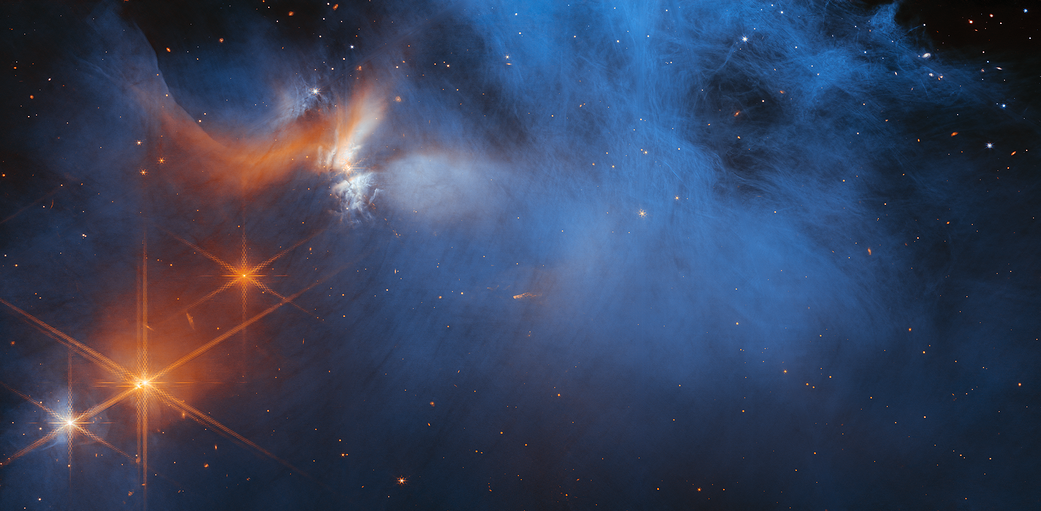An international team of astronomers using NASA’s James Webb Space Telescope has obtained an in-depth inventory of the deepest, coldest ices measured to date in a molecular cloud. In addition to simple ices like water, the team was able to identify frozen forms of a wide range of molecules, from carbonyl sulfide, ammonia, and methane, to the simplest complex organic molecule, methanol. This is the most comprehensive census to date of the icy ingredients available to make future generations of stars and planets, before they are heated during the formation of young stars.
This image from the telescope’s Near-Infrared Camera (NIRCam) features the central region of the Chamaeleon I dark molecular cloud, which resides 630 light-years away. The cold, wispy cloud material (blue, center) is illuminated in the infrared by the glow of the young, outflowing protostar Ced 110 IRS 4 (orange, upper left). The light from numerous background stars, seen as orange dots behind the cloud, can be used to detect ices in the cloud, which absorb the starlight passing through them.
This research forms part of the Ice Age project, one of Webb’s 13 Early Release Science programs. These observations are designed to showcase Webb’s observing capabilities and to allow the astronomical community to learn how to get the best from its instruments. The Ice Age team has already planned further observations, and hopes to trace out the journey of ices from their formation through to the assemblage of icy comets.
Image credit: NASA, ESA, CSA, and M. Zamani (ESA)
一个国际天文学家团队使用NASA的詹姆斯·韦伯太空望远镜,获得了迄今为止在分子云中测量到的最深、最冷的冰层的深入清单。除了像水这样的简单冰块之外,该团队还能够确定各种分子的冰冻形式,从羰基硫化物、氨和甲烷,到最简单的复杂有机分子,甲醇。这是迄今为止对在年轻恒星形成过程中被加热之前,可用于制造未来恒星和行星的冰成分的最全面的普查。
这张来自望远镜近红外相机(NIRCam)的图像显示了位于630光年外的变色龙I暗分子云的中心区域。这片寒冷、纤细的云层物质(蓝色,中央)被年轻的、流出的原恒星塞德 110 IRS 4(橙色,左上角)发出的红外线所照亮。云层后面的橙色点是大量背景恒星发出的光,可以用来探测云层中的冰,这些冰吸收了穿过它们的星光。
这项研究是韦伯13个早期发布科学计划之一冰河时期项目的一部分。这些观测旨在展示韦伯的观测能力,并让天文界了解如何从仪器中获得最佳效果。冰河时期的团队已经计划了进一步的观测,并希望能追溯出冰块从形成到冰彗星的组合的过程。
影像来源:NASA, ESA, CSA, and M. Zamani (ESA)







